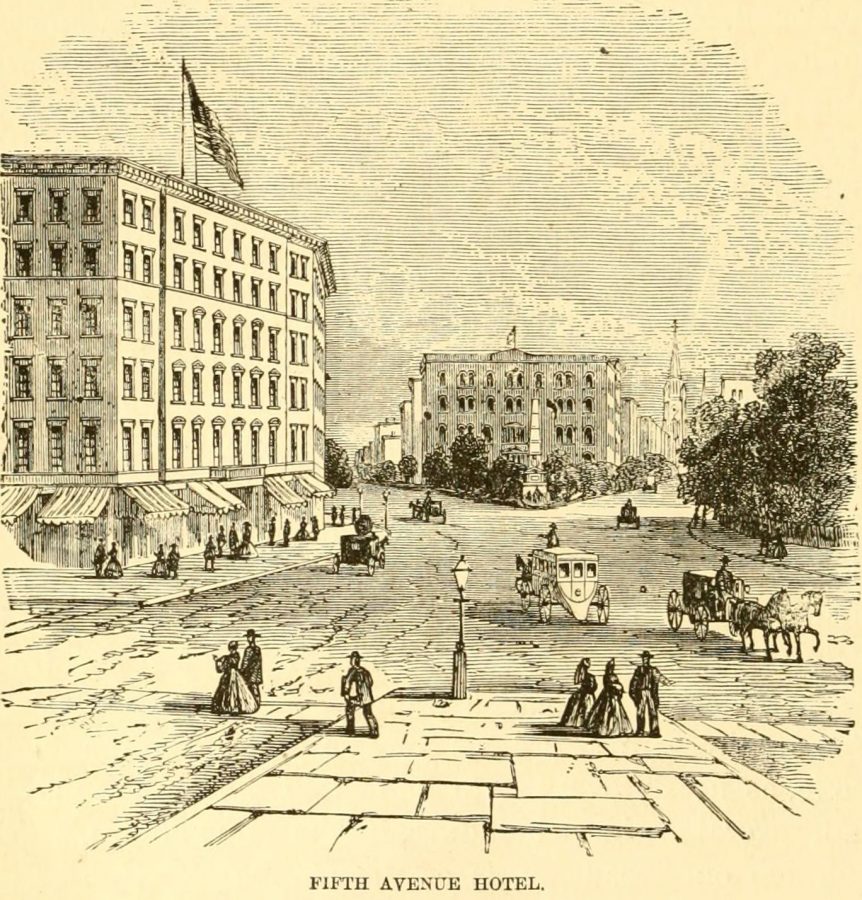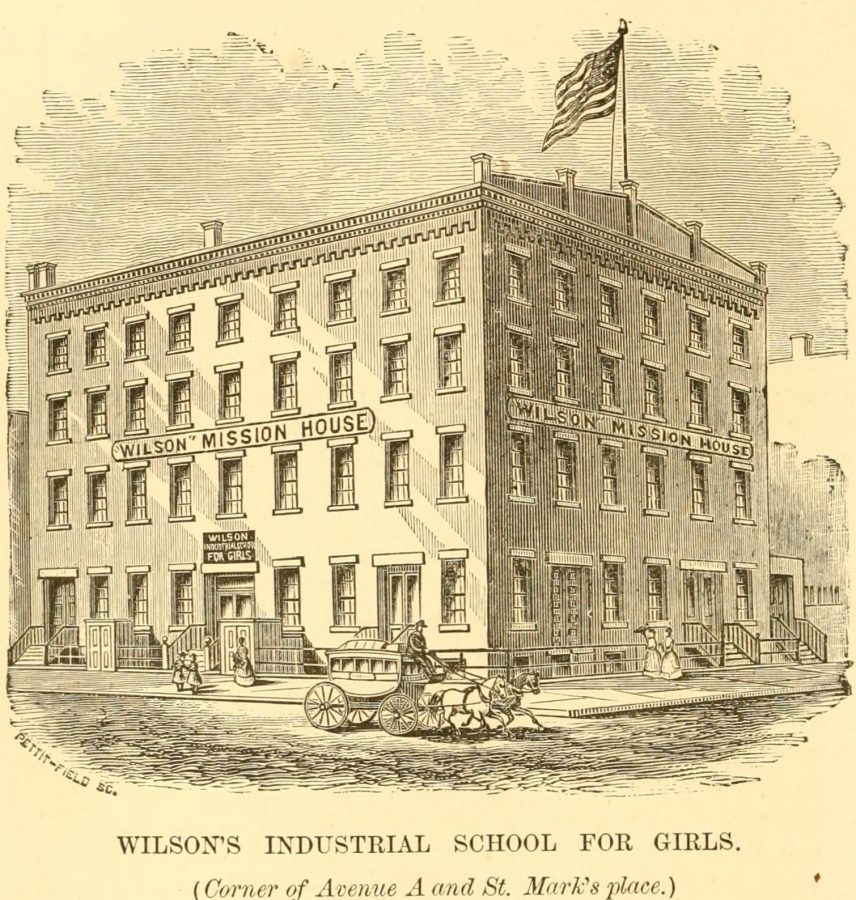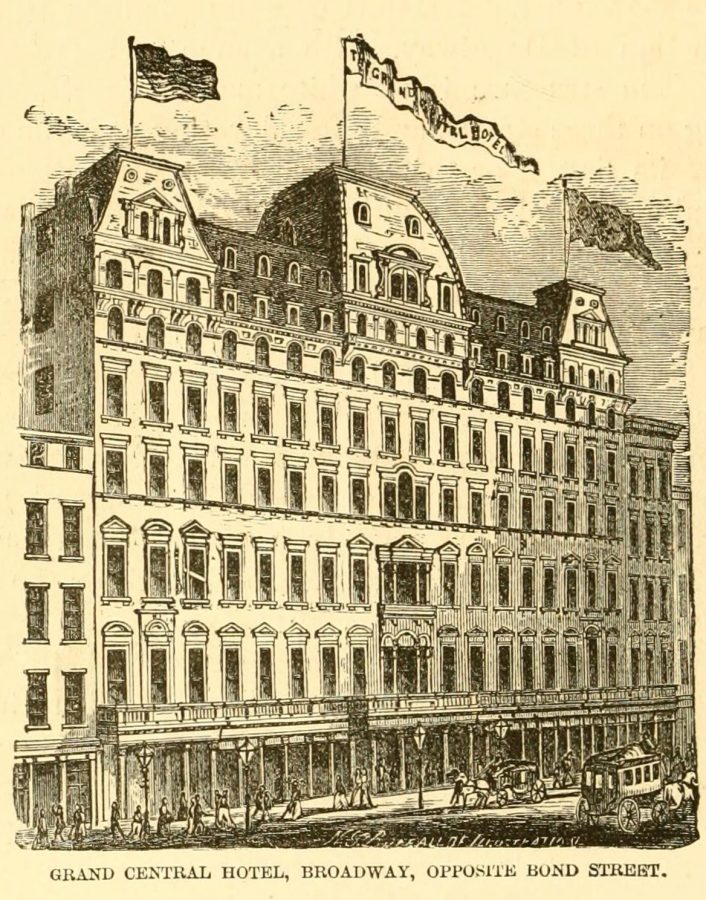Post Office At Broadway & Park Row C. 1880
 From a stereoview circa 1880 we are looking north towards the City Hall main Post Office at the apex of Broadway (left) and Park Row (right). Continue reading
From a stereoview circa 1880 we are looking north towards the City Hall main Post Office at the apex of Broadway (left) and Park Row (right). Continue reading

 From a stereoview circa 1880 we are looking north towards the City Hall main Post Office at the apex of Broadway (left) and Park Row (right). Continue reading
From a stereoview circa 1880 we are looking north towards the City Hall main Post Office at the apex of Broadway (left) and Park Row (right). Continue reading
What was considered obscene 100 years ago? The publishers of a monthly magazine, The International, devoted to fiction, music, drama and politics, were told the January 1914 issue could not be mailed.
Why? The magazine’s cover.
Here is the cover in question. Continue reading

Intersection of Broadway and Fifth Avenue looking north towards the Worth Monument with The Fifth Avenue Hotel on the left (c. 1870)
Demolition of anything old goes on every day without regard for New York’s history. I believe a day will come when all the pre-20th century buildings not given landmark protection will be gone. Demolished in the name of progress. Real estate values rule, not history values. That’s always been the way of New York.
When a historic structure like The St. Denis Hotel is obliterated instead of renovated it is a shame.
I see more and more ordinary tenement and commercial buildings falling at an astonishing rate. So I look around trying to see vestiges of things my great-grandparents might have known and been familiar with.
What did they see?
Recently I took out my copy of Reverend J.F. Richmond’s New York and Its Institutions 1609-1871 (E.B. Treat; 1871) and started to re-read it. I had forgotten how many excellent illustrations were in the book. Belying the name, New York and Its Institutions is not solely focused only upon hospitals, asylum, charity and worship facilities. The book thoroughly covers other important sites and buildings with their respective histories. Though it was not written as a guide book, it essentially is one.
What my ancestors saw were these historic buildings which are now not even memories to most New Yorkers, most having been taken down over a hundred years ago,
Let’s take a look at what New York City looked like around 1871 and take in what the visitor and native New Yorker would have seen.
 Very few lamented the loss of the old Post Office at the corner of Nassau and Liberty Street – — until they saw what replaced it in 1875.
Very few lamented the loss of the old Post Office at the corner of Nassau and Liberty Street – — until they saw what replaced it in 1875.
 The modest Police Department headquarters at 300 Mulberry Street was replaced in 1909 by a grand structure on Broome and Centre Streets.
The modest Police Department headquarters at 300 Mulberry Street was replaced in 1909 by a grand structure on Broome and Centre Streets.
 Wilson’s Mission House or Industrial School For Girls at 27-29 Avenue A corner of St. Mark’s Place across from Tompkins Square Park.
Wilson’s Mission House or Industrial School For Girls at 27-29 Avenue A corner of St. Mark’s Place across from Tompkins Square Park.
 The Grand Central Hotel stood on the west side of Broadway opposite Bond Street between Amity and Bleecker Street. Illegal alterations caused a major collapse of the Broadway facade on August 3, 1973. Incredibly only four people were killed. The remaining section of the hotel was soon demolished. Continue reading
The Grand Central Hotel stood on the west side of Broadway opposite Bond Street between Amity and Bleecker Street. Illegal alterations caused a major collapse of the Broadway facade on August 3, 1973. Incredibly only four people were killed. The remaining section of the hotel was soon demolished. Continue reading
The National Civic Art Society has developed a plan to entirely rebuild the original Penn Station.
The biggest and most obvious hurdle to accomplishing the Society’s plan would be demolishing the many buildings that currently stand on the site including Madison Square Garden and a 34 story office building. Then the next question arises: who would fund such an enterprise?
As crazy as all this sounds, the actual rebuilding plan sounds feasible. You would just need all the corrupt politicians and greedy real estate entities to cooperate. That will almost certainly not occur.
But that doesn’t stop one from hoping. The organizers have an executable plan and want to drum up support among the public. Here is the opening statement from their website rebuildpennstation.org
New York City’s original Penn Station was one of the finest buildings ever constructed. With its vast main hall and soaring concourse, it provided a triumphant gateway into the city. Its demolition in 1963 was one of the greatest architectural and civic crimes in American history.
That wrong is all the worse given the current station, which is cramped, dismal, and hard to navigate. As the historian Vincent Scully said about the original station, “One entered the city like a god; one scuttles in now like a rat.”
We aim to reconstruct the original station to return it to its former glory. Click here to join our cause.
The video the Society produced explains more.
As the rebuild Penn Station group pointed out, New York’s greatest architectural loss occurred 54 years ago.
On October 28, 1963 the demolition of Penn Station began and three years later the majestic station was gone, its marble and debris trucked out in pieces to the New Jersey Meadowlands and used as landfill.
Trains still go in and out of Penn Station. But the Penn Station that replaced the original has nothing in common with the original but the name.
Directly across from the original Penn Station between 31st to 33rd Streets and Continue reading
 We return to one of the most striking and photographed structures of 19th century New York. The main branch of the New York Post Office which loomed over the southern end of City Hall Park for nearly 65 years.
We return to one of the most striking and photographed structures of 19th century New York. The main branch of the New York Post Office which loomed over the southern end of City Hall Park for nearly 65 years.
We are looking north from Ann Street up towards Broadway (left) and Park Row (right).
The scene is typical of an average day in 1880s New York. We can see several trolleys at rest either having completed their runs or about to start them. Several delivery carts are scattered about nearby. A police officer stands in the middle of Broadway keeping an eye on things. A horse drawn hansom coach and driver are prominent in the foreground. Businessmen make their way about the city, many walking on the Belgian block street rather than the sidewalks. Telegraph poles and wires criss-cross Park Row and Broadway.
The hub of all this activity is the main branch of the New York Post Office, designed by Alfred B. Mullett and opened to the public on Sunday, August 29, 1875. Between 8 a.m and 8 p.m. it was estimated that between 20 – 30,000 people wandered into the new building. They passed slowly through its corridors gawking at the shiny new post office lock boxes, looking into delivery windows and buttonholing anybody who looked like an employee to ask questions.
Architecturally inspired by the French Renaissance style, the building proved to be wildly unpopular from the get go. Among the chief complaints about the Post Office was that it was ugly.
More importantly it was located in the wrong place. Continue reading
Stitching together 10 separate photographs from King’s Handbook of New York City (1892) as best I could, this image gives us a 360 degree view of New York City.
Taken from atop Joseph Pulitzer’s New York World Building, you can get a sense of what the entire city looked like before the turn-of-the-century, when the skyscraper emerged and would forever alter the skyline. A golden dome topped Pulitzer’s Building with an observation gallery that gave the visitor the following view.
(click to get the full size view)
 Probably the three most prominent points in the panorama are from left to right, the Post Office, City Hall and the Brooklyn Bridge.
Probably the three most prominent points in the panorama are from left to right, the Post Office, City Hall and the Brooklyn Bridge.
At 309 feet, the World Building designed by George B. Post was the tallest office building in the world when completed in 1890.
Think about that for a minute. Just 26 floors. From the building’s foundation to the top of its flagstaff it measured 375½ feet. At the time that height was an outstanding architectural achievement.
The second floor of the beehive, as the interior of the dome of the World Building was known to its employees, also contained Joseph Pulitzer’s office. Here is how the New York World described the top of its own building just after its completion: Continue reading
The old New York City guidebooks always contain interesting information. These facts are from an 1892 guide.
The New York Post Office handled over 600,000,000 pieces of mail matter annually. That may not be so amazing. What is amazing is that they had an annual profit of $3 million dollars!
Trinity Church is part of Trinity Parish. The Parish was the richest in America. Income from its real estate and other holdings amounted to over $500,000 annually
It was free to walk over the 9-year-old Brooklyn Bridge. Vehicles had to pay a toll of 3 cents each way.
At Centre and Franklin Streets stood the City Prison, better known as The Tombs, because of the architectural resemblance to Egyptian tombs. Before the death by electrocution law went into effect in 1889, all condemned murderers sentenced to death by the New York courts were executed in the Tombs. Continue reading
 This great view of Broadway looking south from Park Place was taken in 1875 by Thorne & Co. publishers of New York City views. With evidence from the shadows and with virtually no street traffic and few pedestrians, this photo apparently was taken early on a Sunday morning.
This great view of Broadway looking south from Park Place was taken in 1875 by Thorne & Co. publishers of New York City views. With evidence from the shadows and with virtually no street traffic and few pedestrians, this photo apparently was taken early on a Sunday morning.
On the right hand side of the photo we see a couple of five story commercial buildings populated with local businesses offering sales including a clothing store, a jeweler and a toy distributor. One sign on the side of the stairs offers soda for a nickel.
The next building taking up the entire west side of Broadway from Barclay to Vesey Streets is the Astor House Hotel. Beyond the Astor House is St. Paul’s Chapel, followed by the recently completed Western Union Building. Further in the distance you can see the spire of Trinity Church. Continue reading
Broadway And The Astor House Hotel circa 1868
We are looking north on Broadway from Barclay Street on what has to be a weekend, as there is hardly any traffic on this normally bustling part of Broadway.
Enlarging the photograph you can see some interesting details. Horse drawn vehicles line up on both sides of the street as a few pedestrians mill about. A glimpse of City Hall Park and its trees can be seen on the right. Architect Alfred Mullett’s main Post Office has not been built yet (1869-1880) and has not encroached upon the southern end of the park, which was sacrificed for that building.
A few gas lamps provide the nighttime illumination for the area. There are also no overhead telegraph wires or poles visible. Surrounding most trees in the foreground are wrap-around wooden advertising placards. In the left hand corner of the photograph is a large ad for the Pennsylvania Railroad, in what may have been the Astor House’s ticketing office.
Besides the interesting view up Broadway, the famous five-story granite Astor House Hotel on the left is the focal point of this photograph. Astor House was built on Broadway between Barclay and Vesey Streets in 1836 by John Jacob Astor. After it opened it was called “the world’s finest hotel.” Presidents and statesmen like Abraham Lincoln, Andrew Jackson, Martin Van Buren, Franklin Pierce, Henry Clay, Daniel Webster and John Calhoun made Astor House their chosen hostelry when visiting New York. Continue reading
These postcards generally depict New York from 1900 – 1920. We are concentrating this batch on the well traveled areas of Broadway and Fifth Avenue.
As the brief description on the card says we are looking south and east along Broadway from Warren Street. The trees on the left belong to City Hall Park. The wide building with the large central rotunda is the main branch of the General Post Office, which was demolished in 1938. Behind the Post Office stands The Park Row Building, which at 391 feet was the tallest office building in the world when completed in 1899. The Singer Building surpassed the height of The Park Row Building in 1908. To the right of The Park Row Building stands the 26 story St. Paul Building built in 1896 and demolished in 1958.
Interesting to note: the flags are at half-staff on the Postal Telegraph and Cable Company Building on the right. Continue reading